Production Planning and Production
This chapter covers the following topics:
- Overview
- Managing Work Orders
- Releasing Work Orders
- Deferring Work Orders
- Canceling Work Orders
- Deferring Maintenance Requirements
- Scheduling Work Orders Using the Scheduler Workbench
- Viewing the Scheduling Hierarchy
- Viewing Serial Number Change History
- Working with Maintenance Requirements
- Updating Material Requirement Details
- Tracking Work Order Materials
- Editing Resource Requirements
- Updating Resource Requirement Details
- Viewing Resource Assignments
- Editing Resource Assignments
- Charging Resources
- Working with Material Transactions
- Viewing and Issuing Materials Across Work Orders
- Returning Materials Across Work Orders
- Identifying the Employee that Items are Issued To or Returned By
- Viewing the Material Transaction History
- Item Disposition
- Disposition Association During Material Transactions
- Updating Dispositions
- Viewing Item/Part Service History
- My Work Orders Interface
Overview
In the maintenance, repair, and overhaul industry, it is necessary to identify, perform, and track maintenance execution to form a complete history of an unit, while maintaining the unit's condition to ensure service availability and capture the costs associated with the maintenance execution. Unit maintenance requires identifying defects, the corrective action steps, material, and resource requirements as well as charging resources, performing material transactions, and maintaining the quality for a job.
The objective of production planning is to evaluate a work package and develop a feasible project plan, including resource allocation by mechanics' skill, material, breakdown man hour by zone or process, and estimate the turn around time for each major process. When a visit work package is updated with non-routine or repair jobs, the production plan will include this information.
The Production Planning module is used by production planners to manage shop floor activities, assign personnel and equipment to jobs, fine tune work schedules, manage procurement, create material requirements for unplanned maintenance, and track components sent out for repair against the maintenance visit.
This module is also used by maintenance personnel to execute the organizations' maintenance program. Technicians and supervisors can view job assignments, view component and material availability, record maintenance activities, material and component consumption, and job completion, update maintenance compliance details, issue quality inspection results to satisfy regulatory requirements, and initiate new service requests for unplanned maintenance discovered during planned maintenance visits. See:
Production
The Production module supports the execution of the tasks against an Installed Base Tracked Item. Production is the actual execution of the work required for a maintenance visit. The execution of the visit accumulates the entire history of the work performed, the inspection findings, and component changes. The production activity provides the information necessary for the records that is required for commercial and regulatory purposes. Production manages the key processes such as receiving a unit for service, disassembling, cleaning and inspecting it as well as dispositioning the parts.
The Production Planning module automates production tasks such as job creation, maintenance and job completions. Once a job is released to the floor, it can be executed. The execution of a job can be routine, disassembly, inspection, assembly, disposition that can lead to scrap, or a part request and repair job creation to correct a deviance. All costs associated with the jobs are collected throughout the repair cycle.
Routine Tasks
A routine task is a job that has been generated from a predefined route setup in the CMRO Route Management module. If a routine task is defined through a maintenance requirement, it may have a schedule and due date as defined by the Unit Maintenance Plan module. The task has been associated with a maintenance visit in the Visit Work Package and released to Production, optionally scheduled in the Planning Workbench, and optionally has resources scheduled by Production Planning.
Non-Routine Tasks
When a non-routine requirement is discovered, these non-routine, or unplanned jobs can be completed in the originating visit or deferred to subsequent visits. Non-routine tasks consist of a service request tracking the problem, and a job consisting of the steps required to resolve the problem. A non-routine task may have additional routes associated with it in the Visit Work Package to support the resolution. You can create service requests using the Service Request window in Oracle TeleService. You can also create non-routine service requests in the Unit Maintenance Plan region of the Planning module. These requests can be deferred to subsequent visits using MEL or CDL instructions. See: Creating Non-routine Requests During Unit Maintenance
Key Business Processes
The Production module of Oracle CMRO supports the following business processes:
Search for Routine and Non-Routine Work Orders
After a routine work order or non-routine work order is created, the work order can be selected from the results of a search using the specific filtering elements.
Create Work Orders from Visit Tasks for Scheduled, Unscheduled, and Convenience Maintenance
Work orders are created in production when the tasks are pushed to production from visit work package or when a service request, from Oracle CMRO Production module is created in a visit where the tasks have been pushed to production.
Create Service Requests to Track Reported Problems
Service requests are created when an item has a service difficulty, requiring an action to address the issue. During the service request creation, a visit task is created and a job is created if the visit's tasks have been pushed to production. The service request creation will also be generated when an Installed Base tracked item is returned or removed in the Unserviceable or MRB condition.
Create Operations to Non-Routine Work Orders for Work Definition and Tracking
For on-route based work orders the user can create operations to describe the steps required to correct the service difficulty. For route based work orders, the operation steps are created from the definition in Route Management including the associated material and resource requirements that are valid for the execution organization.
Maintain Work Orders
The user maintains the work order by adjusting the schedule, the status, completing, deferring, and selecting the actual start and end for a work order. In addition, the user can select if the work order is confirming the jobs necessity by selecting the confirmed failure flag. When a work order is completed, it triggers a check to determine if the work order is the last part of a maintenance requirement. If the work order was the last work order to be completed for a maintenance requirement, the counters are reset as defined by the Fleet Maintenance Program, and the unit maintenance plan is updated to reflect that the maintenance requirement is complete.
Maintain Operations
The user maintains the operations by updating the operations, updating the material and resource requirements, capturing costs by charging resources, issuing and returning materials, viewing the resource assignments, recording part changes, and completing the operations.
Maintain Quality
Quality is maintained using the route setup from Route Management for the work order and operation compliance, and from the profile options for non-routine work order and operation compliance, job deferral, MRB part disposition support, and by capturing counter readings at the job completion. The quality results are captured based on the storage setup in Oracle Quality.
View Service History
During the planning phase of a service or the execution of a work order, planners access the history of service performed against a unit or part. Planners will then compare the current and future requirements and schedule the tasks to be performed. Planners can also review the past, current and future maintenance requirements against a part or item.
Managing Work Orders
The Production module is the interface used to perform the various activities related to work orders. You can update, release, cancel, defer, and complete work orders, and create non-routine work orders arising out of maintenance needs discovered on the production floor. You can also view documents, scheduling hierarchy, material, and resource requirements associated with the work orders. See:
Releasing Work Orders
-
Navigate to the Execution region, and select the Production Planning tab. The Work Order Overview page appears.
-
Enter information in the applicable fields and click the Go button. All jobs matching your search criteria appear in the Work Order List Results table.
-
Select the work order that you want to release and choose Release Work order from the drop-down menu.
Optionally, you can navigate to the Work Order Operations page and update the work order status to Released.
-
To release all the work orders within a particular visit, choose Release Visit Work Order from the drop-down menu. Optionally, you can also navigate to the Search Visit page under the Production Planning tab. Search for a visit and release all the work orders associated with that visit.
-
To release work orders for a particular maintenance requirement, choose Release Maintenance Work Order from the drop-down menu in the Work Order List table. This option is also available in the Search Maintenance Requirements page under the Production Planning tab.
Deferring Work Orders
-
Navigate to the Execution region, and select the Production Planning tab. The Work Order Overview page appears.
-
Enter information in the applicable fields and click the Go button. All work orders matching your search criteria appear in the Work Order List Results table.
-
Select a work order, and select Defer/Cancel from the drop-down menu.
Optionally, you can defer the work order from the Work Order Operations page.
The Maintenance Requirement Deferral Details page appears.
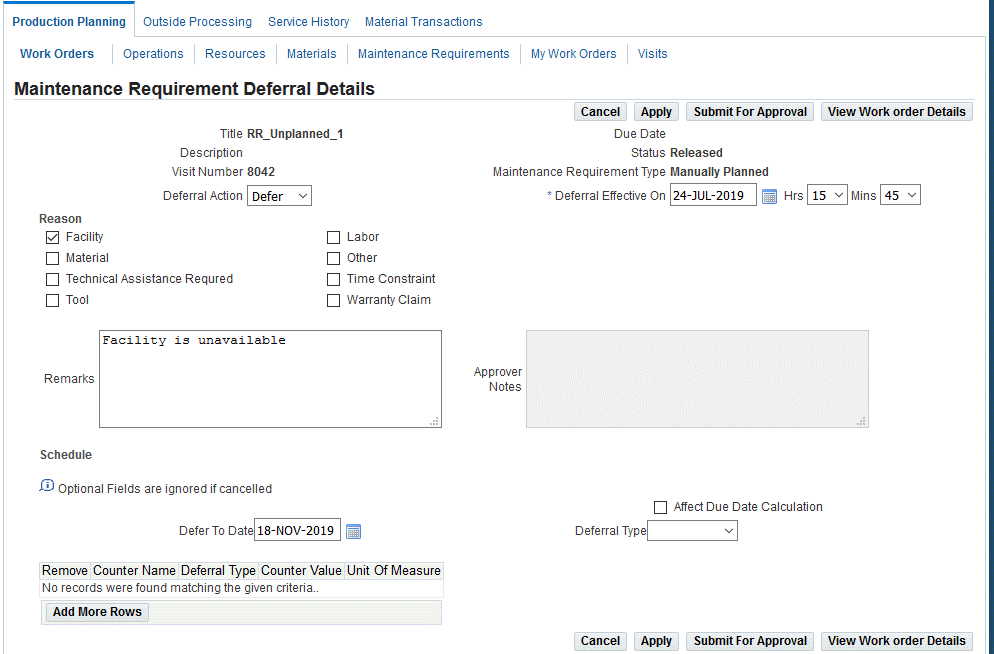
-
Enter deferral information on the page.
-
Click Apply to save your work.
Canceling Work Orders
A method is introduced to restrict access for canceling work orders to specific users. Users can cancel work orders based on a status of Released, Unreleased, or both.
These two security functions must be set for all users:
-
AHL_PRD_CANCEL_REL_JOBS
-
AHL_PRD_DISALLOW_CANCEL_JOBS
The function, AHL_PRD_CANCEL_REL_JOBS, enables the users to use the Cancelled option for any work order if the work status change rules allow the canceling of the work order.
The AHL_PRD _DISALLOW_CANCEL_JOBS function does not include the Cancelled work order option.
If both these functions are not enabled, the users can cancel Unreleased work orders only.
Deferring Maintenance Requirements
You can defer routine and non-routine maintenance requirements not completed during a visit, either due to the shortage of material and resources, or because the unit was put back into service for an emergency assignment. You can also defer maintenance requirements belonging to a group maintenance requirement (MR). The group MR is signed off at the end of the visit, and the deferred MR is carried out at a later date, and accomplished with the group MR on the next group MR event. Maintenance requirements can be deferred to a future date (hard date when this MR will be performed), or they can be based on counter threshold values. A deferred maintenance requirement with a new due date is created in the Unit Maintenance Plan module.
You can skip a planned maintenance requirement to the next repetitive MR, and also push the next due date based on the deferred date.
To defer a maintenance requirement
-
Navigate to the Search Maintenance Requirements page.
-
Select the maintenance requirement that you want to defer, and click the Defer button. The Maintenance Requirement Deferral Details page appears.
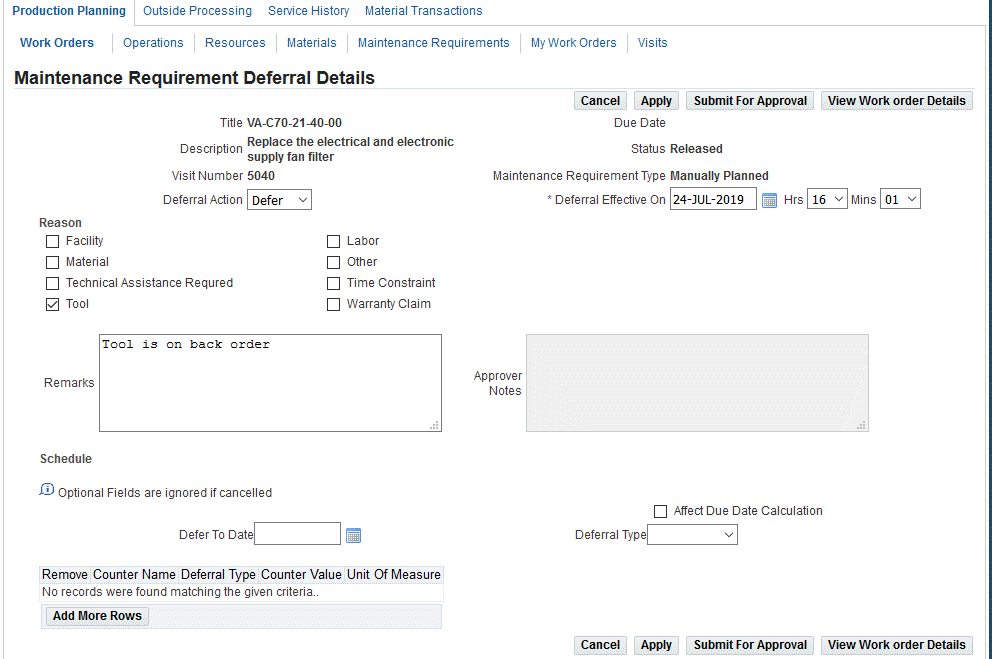
Use the information in the following table to enter deferral details.
Field Name Description Title The title of the maintenance requirement, that you want deferred. Description Maintenance requirement description. Visit Number An alphanumeric value that uniquely identifies the visit definition that you wish to retrieve. Due date Due date of the maintenance requirement. Status Seeded work order status of the maintenance requirement. Reasons User-defined reasons to apply to the deferral. Remarks Multiple lines field to enable users to enter additional information related to their deferral request. Approver Notes Multiple lines field to enable the approver to enter approval or rejection information. Defer To Date The date to which the maintenance requirement is going to be deferred. Deferral effective on Date that the deferral is being created. The default value is the system date. Counter Name Fleet Maintenance Requirement threshold counter name. Deferral Type Deferred By counter UOM or Deferred To counter UOM value. -
Choose the deferral reasons by selecting the corresponding check boxes in the Reasons region. You can select more than one deferral reason. Enter information in the Remarks field.
-
Enter the Defer to Date or select a date from the Oracle calendar to defer the maintenance requirement.
-
Enter a date in the Deferral Effective On field. Alternatively, select a date using the Oracle Calendar.
-
To defer the maintenance requirement based on counter readings, select Add More Rows, and enter the counter threshold values.
-
Enter a counter name. UOM that appears is based on the selected Counter Name.
-
Choose Defer By or Defer To from the Deferral Type drop-down menu. Enter a counter value.
Note: The system will return an error message if the deferred date or deferred counter is equal to or greater than the next due date or due counter for the repetitive maintenance requirement.
-
If you select the Affect Due Date Calculation check box, the unit maintenance plan uses the new deferred date or counter value, to calculate when repetitive requirements will be due again.
-
Select the Skip Maintenance check box to remove this instance of the requirement from Unit Maintenance Plan without affecting subsequent forecasted requirements.
-
Click the Apply button to save the record. You can optionally click the Cancel button to cancel the transaction.
-
Select View Work Order Details. The Work Order Overview page appears where you can view all the work orders related to MR that you want to defer.
-
Select Submit for Approval to submit the deferral for approval. The status changes to Approval Pending.
-
When the deferral is submitted for approval, all the work orders associated with the MR are put on hold.
-
On approval, all work orders in the Released status and associated with the MR are completed, and all Unreleased work orders are cancelled. A new UMP is created to track the deferred requirement in the Unit Maintenance Plan module if the deferral is not to skip the MR.
-
If the deferral is rejected, all associated jobs statuses are reverted to their previous statuses. You can resolve the errors and resubmit for approval.
Note: You cannot submit a deferral for approval if a child MR is pending deferral approval.
-
Scheduling Work Orders Using the Scheduler Workbench
Before a work order is executed, the planner must balance the requirements (resource and materials) with the available supply and capacity, also known as resource leveling. The planner assigns the work orders so that the resources are consumed at a balanced rate. The Scheduler Workbench provides a graphical user interface of the visit's work hierarchy, and enables the planner to schedule work orders and operations, manage dependencies, and assign resources. The scheduling decisions are validated against the applicable maintenance visit's start and end dates, as well as the defined technical dependencies between production work orders.
A large maintenance operation can have multiple visits and thousands of work orders at a single facility. The Scheduler Workbench enables the planner to quickly schedule and reschedule work orders, while viewing the required and available resources, and the work order dependencies.
The scheduling hierarchy and the completion dependencies of a visit are pushed to Oracle Work-In-Process (WIP). Completion dependencies are the technical dependencies between visit tasks in the Visit Work Package module. For example, Task 3 is executed after Task 1.
Prerequisites
- To use the Enterprise Asset Management Scheduler Workbench, work orders must have been created.
- After creating a visit in Visit Work Package, associating the applicable maintenance requirements and schedule the visit to an available organization and department, work orders are created by pushing the visit to production.
Related Topics
Using the Scheduler Workbench, Oracle Enterprise Asset Management User's Guide
Viewing the Scheduling Hierarchy
You can view the completion dependencies for a work order using the View Work Order Scheduling Hierarchy page. The selected work order information appears as read-only information.
To view the scheduling hierarchy
-
Navigate to the Work Order Overview page.
-
Enter information in the applicable fields and select Go. All work orders matching your search criteria appear in the Work Order List Results region.
-
Select the work order, and choose View Scheduling Hierarchy from the drop-down menu.
Click Go. The Work Order Scheduling Hierarchy page appears, displaying the work order details, and the related work orders.
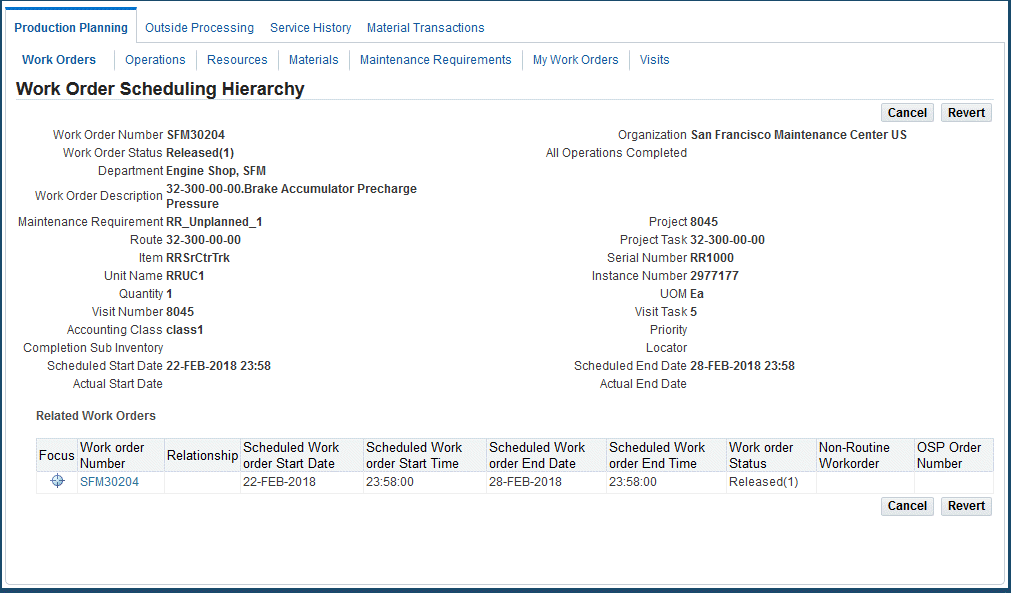
-
Click the Focus icon for a specific work order to view the relationships.
-
Click the Work Order number link to access the Work Order Operations page.
Viewing Serial Number Change History
You can view all serial number changes performed for the work order item instance using the Serial Number History page.
To view the serial number change history
-
Navigate to the Item Number/Serial Number Change page. See Changing Item and Serial Numbers Associated with Work Orders.
-
Select View History. The Serial Number History page appears, displaying the following information about the serial number changes:
-
Date
-
Old Serial Number
-
Old Serial Tag
-
New Serial Number
-
New Serial Tag
-
Working with Maintenance Requirements
You can search for maintenance requirements associated with work orders and perform all actions including deferring, signing off, submitting quality results, and viewing relationships using the Maintenance Requirements tab.
To work with maintenance requirements
-
Access the Production Planning tab, and click the Maintenance Requirements tab. The Search Maintenance Requirements page appears.
-
Enter your search criteria and click the Go button.
-
You can select a maintenance requirement and perform one of the following:
-
Defer
-
Submit Quality Results
-
Sign off
-
View associated work orders
-
View relationships
-
-
Click the Maintenance Requirements link. The View Maintenance requirement page appears where you can view details, associated documents, routes, effectivities, relationships, affected items, and if the MR is controlled by software updates.
-
Optionally, select a maintenance requirement and click View Work Orders. The Maintenance Requirement Work Orders page appears displaying information about the work orders associated with a maintenance requirement.
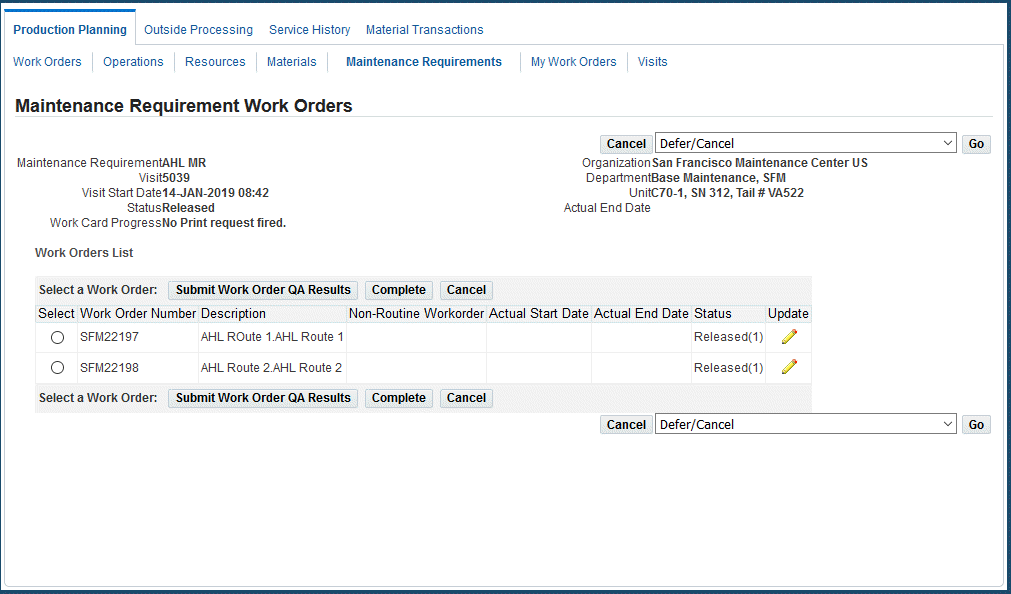
You can perform the following:
-
Submit quality results and complete work orders.
-
Navigate to the Update Work Order Operations page by clicking the Update button in the work order results.
-
Navigate to the View Service Request page by selecting Service Request.
-
Submit quality results, sign off and defer the maintenance requirement.
-
Updating Material Requirement Details
- A work order with a status of Draft, Unreleased, Parts Hold, Hold, or Pending QA status must exist in the database. The WIP Mass Load Concurrent Program must be running. The operation must have a Uncomplete or Pending QA status.
To update material requirement details
-
Click the Execution link, and select the Production Planning tab. The Work Order Overview page appears.
-
Enter information in the fields, and then click the Go button. All work orders matching your search criteria appear in the Work Order List Results region.
-
Click the Work Order number. The Work Order Operations page appears.
-
Click the Materials link, and Update Material Requirement page appears.
-
Select the material requirement that you want to update, and click the Details button. The Material Requirement (Detail) page appears.
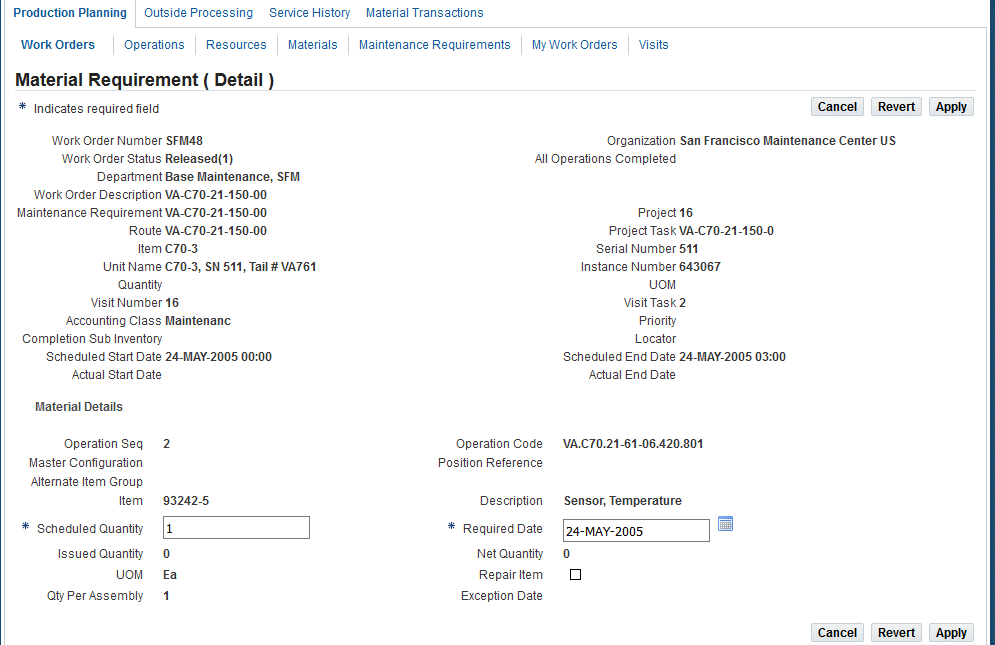
Use the information in the following table to modify the material requirement details.
Field Name Description Operation Sequence The job's operation sequence number. Operation Code The standardized operation code. Item The item number for the requirement. Description The description of the item defined. Scheduled Quantity The quantity scheduled by Planning. Required Date The date on which the requirement is expected. Issued quantity Part quantity issued. Net Quantity The difference between total quantity issued and total quantity. UOM The unit of measure for the item's quantity. Quantity per Assembly Part usage quantity. -
Make the required changes, and click the Apply button. Click the Cancel button to cancel any changes and return to the previous page.
Note: When changing an existing requirement defined in Route Management, the selection is limited to the alternates for the item.
Tracking Work Order Materials
Use the Workorder Materials link to access the Workorder Materials (Tracked) page.
-
Click the Execution link, and select the Production Planning tab. The Work Order Overview page appears.
-
Enter information in the fields, and then click the Go button. All work orders matching your search criteria appear in the Work Order List Results region.
-
Click the Work Order number. The Work Order Operations page appears.
-
Click the Workorder Materials link in the side navigation.
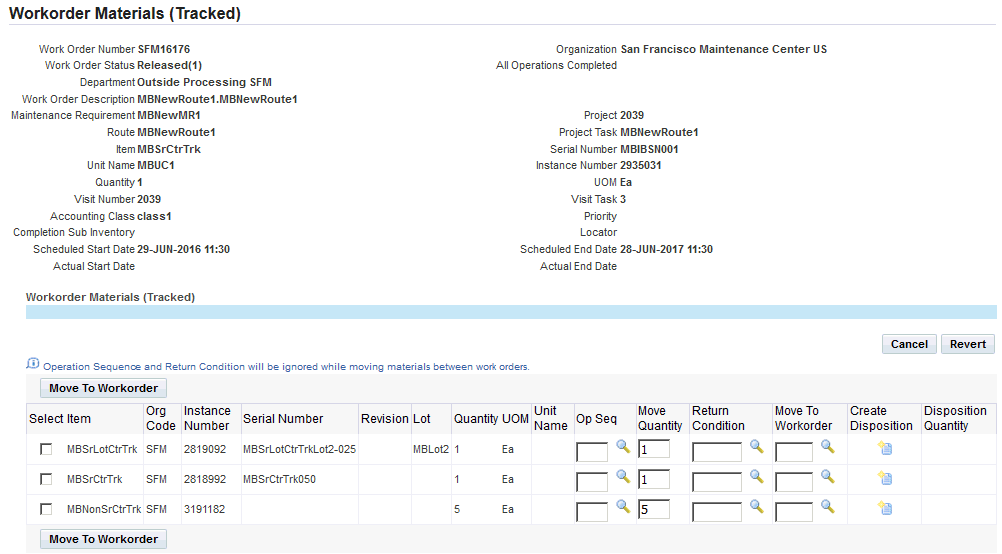
-
The tracked items that exist in the work order display.
This is a list of materials (by serial number) that have been issued to the WIP job and operation sequence, removed from a configuration through a Parts Change transaction, or moved to this work order from a different work order through a Move To Workorder transaction.
You can change the Move Quantity.
-
Select the item and click the Move To Workorder button to move or transfer the material to the destination work order indicated in Move To Workorder column.
-
Click the Create Disposition icon to create a disposition against the work order material item.
Editing Resource Requirements
- A visit or work order with associated requirements must exist in the database.
To edit resource requirements and view summaries and details
-
Find the work order or operation you want to edit. See Finding Work Orders
-
Navigate to the Resource Requirements page.
-
Make any necessary changes to the items displayed in the Resource Requirement list.
-
Click Add More Rows to add a resource requirement.
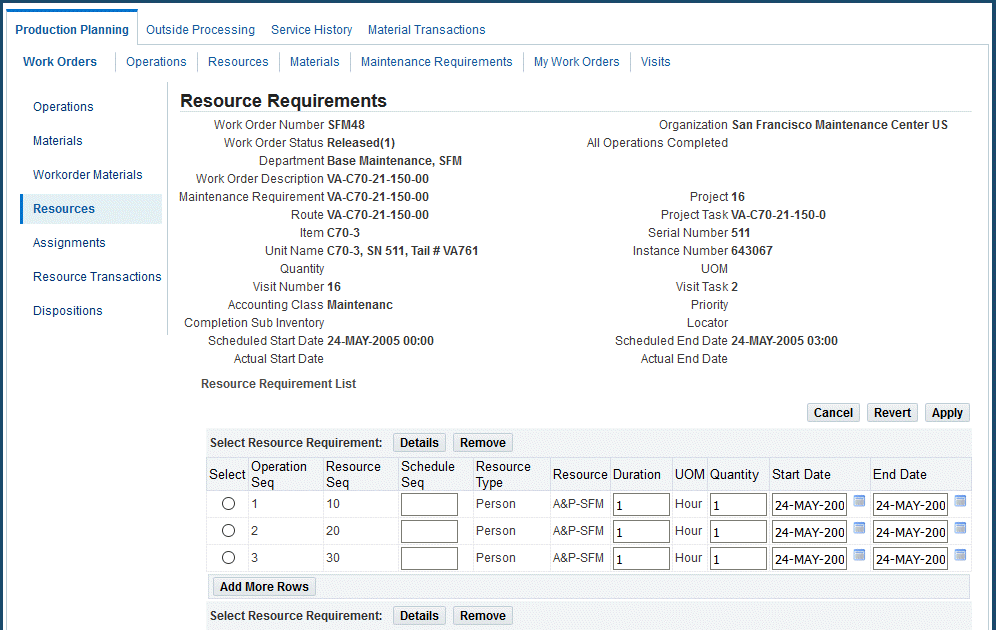
Use the information in the following table to modify resource requirements.
Field Name Description Operation Sequence The work orders operation sequence number. Resource Sequence The sequence number for the resource within an operation. Resource Type The type of resource requirement. Resource The resource name within the operations department. Duration The length of time required. UOM The unit of measure for the time required. Quantity The quantity of resources required. Start Date The start date for the resource. End Date The end date for the resource. -
Click the Apply button to save your changes.
Click the Cancel button to cancel changes and return to the Work Order Overview page.
Updating Resource Requirement Details
- A work order with a status of Draft, Unreleased, Parts Hold, Hold, or Pending QA status must exist in the database.
- The WIP Mass Load Concurrent Program must be running.
- The operation must have a Uncomplete or Pending QA status.
To update the resource requirement details
-
Navigate to the Work Orders page (Execution > Production Planning >Work Orders. The Work Order Overview page appears.
-
Enter information in the fields then click the Go button. All work orders matching your search criteria appear in the Work Order List Results region.
-
Click the work order number. The Work Order Operations page appears.
-
Select Resources from the left-hand navigation bar. The Update Resource Requirement page appears.
-
Select the requirement you want to update and click the Details button. The Resource Requirement Detail page appears.
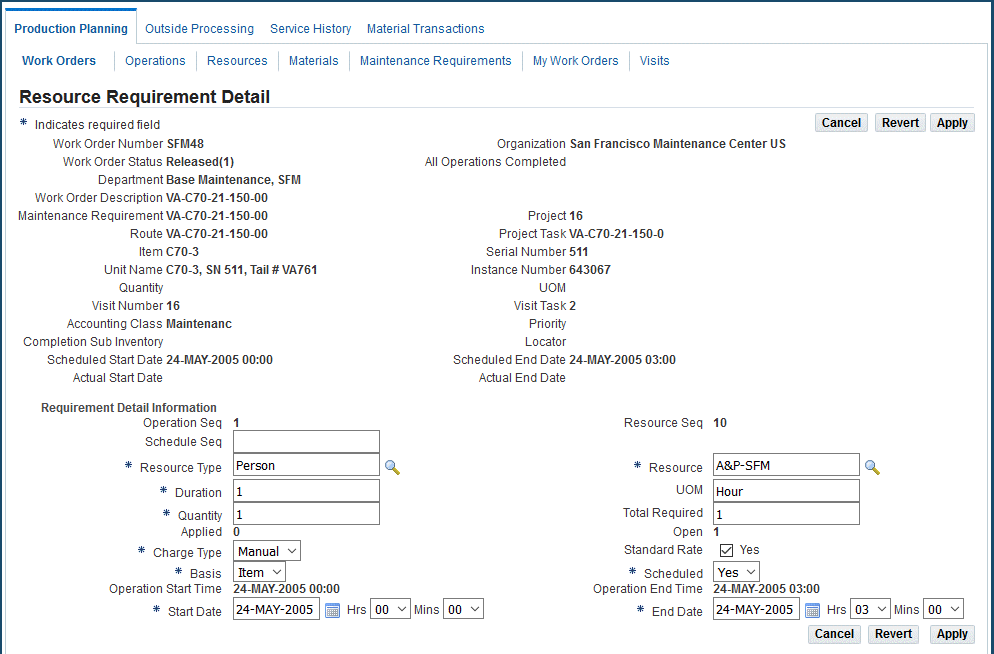
Field Name Description Operation Sequence The work order operation sequence number. Resource Sequence The sequence number for the resource within an operation. Resource Type The type of resource requirement. Resource The resource name within the operations department. Duration The length of time required. UOM The unit of measure for the time required. Quantity The quantity of resources required. Total Required The total amount of time required derived my multiplying the duration with the quantity. Applied The duration of the resource charged to date. Open The duration of the resource difference between the Total Required and the Applied amount. Charge Type The expected method of charging the resource. Standard Rate Determines if the resource is to be charged at the standardized rate. Basis Provides the basis for determining the resource requirement. Operation Start Time The date on which the operation is scheduled to start. Operation End Time The date on which the operation is scheduled to end. Start Date The start date for the resource. End Date The end date for the resource. -
Make the required changes, and click the Apply button. Click the Cancel button to cancel any changes and return to the previous page.
Note: When changing an existing requirement defined in Route Management, the selection is limited to the alternates for the item.
Viewing Resource Assignments
-
Find the work order for which you want to view assignments. See Finding Work Orders
-
Navigate to the Work Order Operations page. Click the Assignments link and the Resource Assignments page appears.
-
Make any necessary changes to the items displayed in the Resource Assignment list. Click the Add More Rows button to add assignments.
-
Click the Apply button to save your changes.
Editing Resource Assignments
-
Find the work order with the assignments that you want to edit. See Finding Work Orders
-
Navigate to the Resource Assignments page.
-
Make any necessary changes to the items displayed in the Resource Assignment list.
-
Click the Apply button to save your changes.
Charging Resources
-
Navigate to the Work Order Overview page (CMRO Super User > Execution > Production Planning).
-
Enter information in the fields,
-
Click Go.
-
Click the work order number, and the Work Order Operations page appears.
-
Click the Resource Transactions link, and the Perform Resource Transactions page appears.
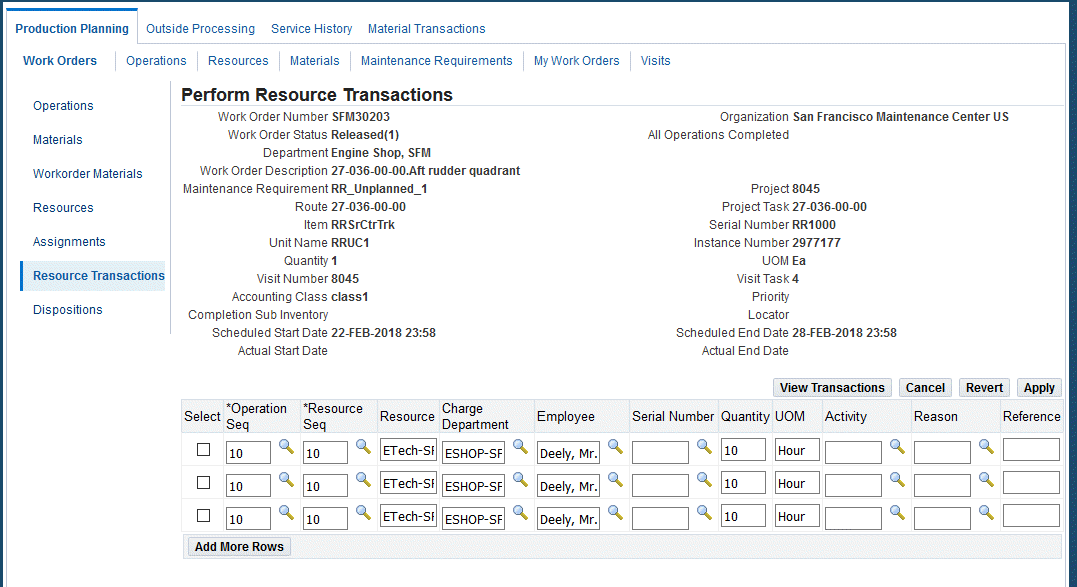
-
Make any necessary changes and click the Apply button to save your changes.
Note: You can disable the Resource Transactions side menu bar in the Resource Requirements page by running a specific function. This minimizes the chances of incorrect labor and usage costing.
-
Click the Add More Rows button to add charged resources.
Working with Material Transactions
Using the Production Planning module, users can issue and return materials to inventory with a single work order, identify the employee that items are issued to or returned by, and view the material transaction history. This enables a user to perform material transactions across work orders rather than having to drill into all work orders.
See:
Viewing and Issuing Materials Across Work Orders
Users can view material requirements, identify the materials previously issued against these requirements, and determine which items must be issued for each job, based on the defined requirements.
To view material requirements and issue materials across work orders
-
Navigate to the Material Issue page (CMRO Super User > Execution > Material Transactions).
The Material Issue page appears.
-
Enter search criteria and click the Go button. Material requirements across work orders matching your search criteria appear in the Work Order Requirements region.
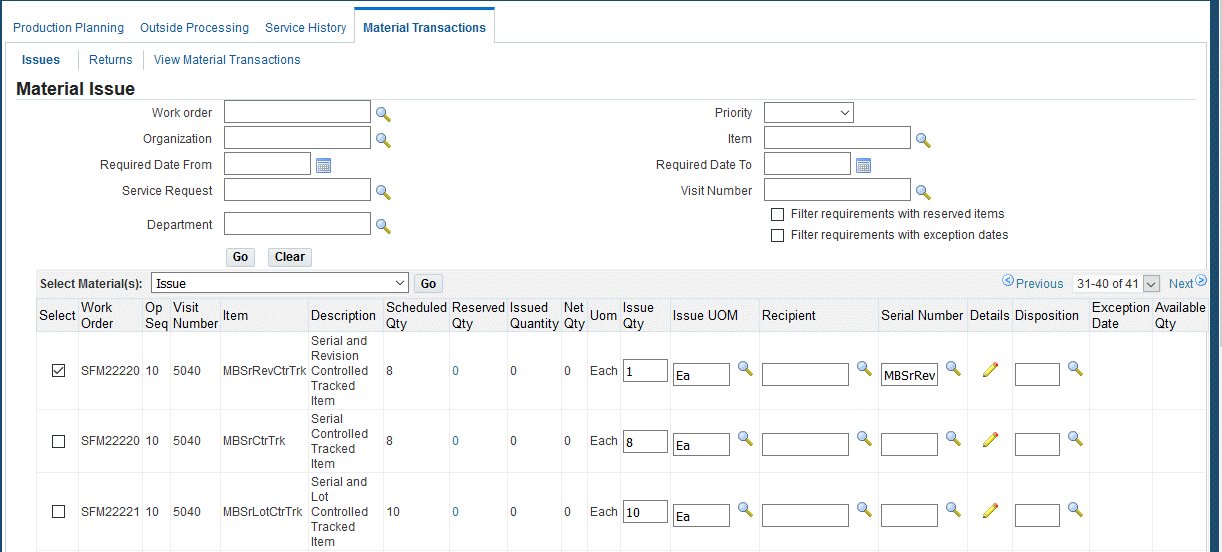
-
The item and the required quantity appear for each work order.
The Issued Quantity default value comes from the material requirements and the net quantity is calculated as the difference between total quantity issued and total quantity returned. You can change the quantity as required.
-
Select the UOM and the Recipient.
If the issued quantity is 1, select the serial number of the item from the Serial Number list of values. Optionally, you can associate disposition to the material issued by selecting it from the Disposition list of values.
-
Optionally, click the Details icon to navigate to the Material Issue Details page and enter the lot, revision, locator, and subinventory information if the item is controlled in inventory.
-
Click Done to apply this information and return to the Material Issue page.
-
Select the work orders for which you have entered the issue details and click Issue. The required items are issued to the work order.
Returning Materials Across Work Orders
Users can query for items that have already been returned or that need to be returned and also search for items that were issued, but not completely used to complete the applicable job. Multiple items can be returned at the same time without the user having to navigate to a single job or associated visit. Users can also manually identify the issued items that will replace the non-tracked parts that will be returned.
To return materials across work orders
-
Under the Material Transactions tab, click the Returns tab.
The Material Returns page appears.
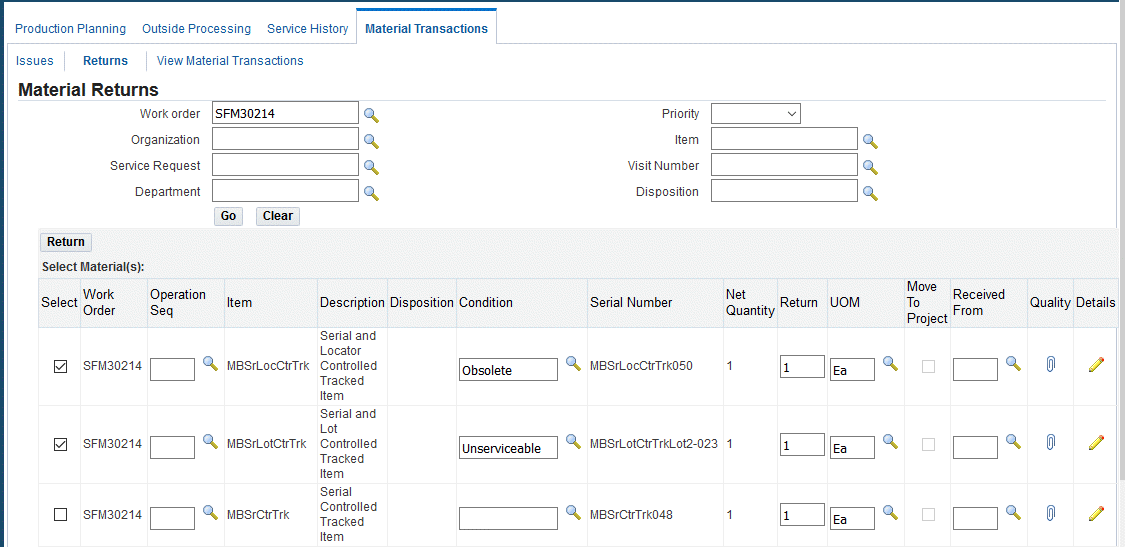
-
Enter your search criteria and click Go. The work orders matching your search criteria are listed in the Work Order Return Results region. The following two types of material are available for return:
-
Material that was issued to the job. If the material has associated dispositions, then each disposition is shown as a separate return line.
For non-serialized items, the default net quantity available to return will be (Total of all Issues - Total of all Returns) for the given material. The returned material should not be more than the disposition quantity if a disposition is associated.
-
Material that was not issued to the job but has a disposition associated to it.
For tracked items removed from the unit configuration, a disposition will be created automatically, if it does not already exist.
The item and the net quantity appear for each work order.
-
-
Enter the quantity to be returned.
The quantity to be returned must be 1 if the item number is serial number controlled. In addition, the quantity should not be more than the net quantity. When a disposition is associated to the return, the quantity to be returned should not be more than the net disposition quantity.
-
Select the UOM and the employee from which it is received from the UOM and Received From respectively.
-
Optionally, choose the condition in which the item is returned. The condition default value appears when a disposition is associated.
-
Click the Details button to enter additional information, and the Material Return Details page appears.
The serial, lot, and locator information must be provided if the item is controlled in inventory.
The Locator and Subinventory fields are populated with default values that come from WIP_PARAMETERS. The Transaction Date should not be later than the system date. The Reason and Problem Code will not appear if a disposition is associated with the item.
-
To enter quality results, click the Quality icon.
You must enter quality results if the condition is MRB and when no disposition is associated with the material return.
-
After entering the required details, select the work order and click the Return button to return materials.
A service request is created for all unserviceable tracked parts that are returned.
-
Click the Done button to apply changes and return to the Material Returns page.
Identifying the Employee that Items are Issued To or Returned By
A high level of accountability is maintained whenever a material transaction is performed. Material transaction details items, serial numbers (if applicable), quantity, employee, operations and the date of the transaction are stored. Organizations track each issue and return made against work orders. Users can identify the employees to whom the material is issued and also the employees who return the items.
The AHL_MTL_ISSUE_RETURN_EMPLOYEE profile must be set to Yes.
Users can query for employee names using the Recipient and Received From values in the Material Issue and Material Return pages respectively.
Viewing the Material Transaction History
The View Material Transactions page displays a summary of all material requirements and their associated transactions.
Prerequisites
- Valid work orders must exist, and materials associated with and transacted against them.
To view the material transaction history
-
Under the Material Transaction tab, click the View Material Transactions tab. The View Material Transactions page appears.
-
Enter your search criteria and click the Go button. The results display both issue and return transactions history.

-
You can perform the following actions:
-
View the details of the transaction by clicking the Details icon.
-
Associate the transaction to existing dispositions.
-
View the Service Request details.
-
Click the Work Order number link to navigate to the Work Order Operations page and view details associated with the work order.
-
Item Disposition
Disposition lists are defined in Route Management as a subset of a composition list or master configuration to compliment material requirements and to set up planning percentages. Disposition lists can also act as a superset if additional materials are defined for the item or configuration. When a work order is created based on a route, the disposition list associated with the route is carried over into production where the maintenance user can specify the disposition details as well as add items from the composition list, which have not been previously defined in engineering. Maintenance or inspection personnel use the disposition details to transact the material (serviceable/non-serviceable) and initiate overhaul, repair or scrap requirements. Maintenance or inspection personnel can create and view the discrepancies/non-conformances recorded, create a material requirement based on the disposition item, initiate the removal and installation of tracked parts, and initiate the capturing of the MRB quality disposition information.
Note: For an unserviceable part, if you first create a non-routine requirement and subsequently remove the part, process the part removal results in the part being transferred to the non-routine work order.
Prerequisites
- Items must have been set up in inventory.
- A composition list must exist for the item.
- A disposition list must have been created for the item- route or the master configuration- route combination. There must be a work order for which to disposition the item or position against.
To disposition items in production
-
From the Work Order Overview page, select a work order and navigate to the Work Order Operations page
-
Click the Dispositions link.
The Work Order Dispositions page appears displaying the disposition list associated with the work order.
The Disposition List includes all the default dispositions which are automatically generated when the work order is created (based on the route_ID associated with this work order), dispositions created by the user and the dispositions created or updated by the corresponding part changes.
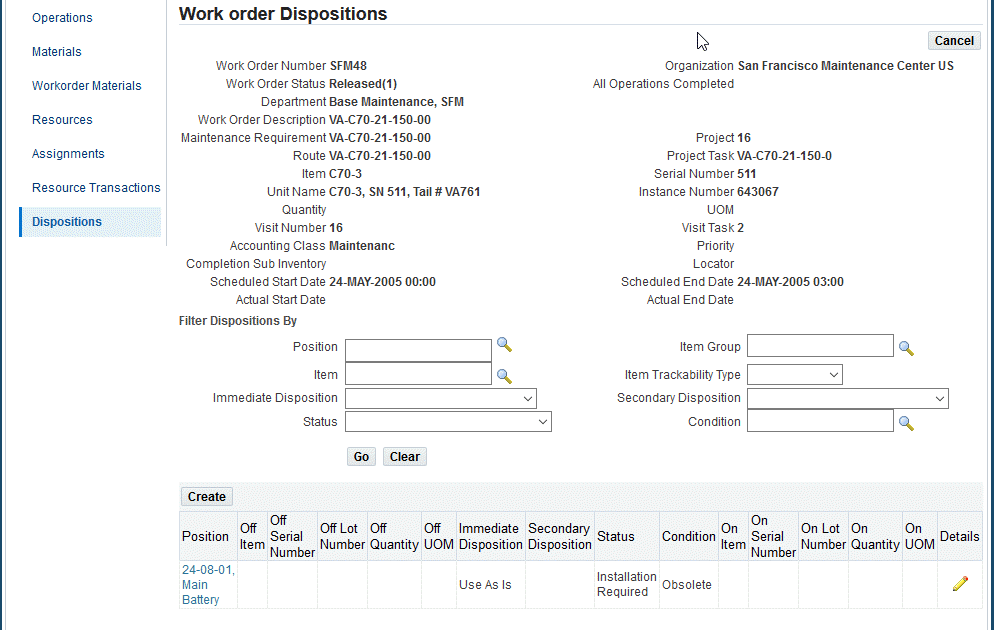
You can perform the following:
-
Create a new entry by clicking the Create button.
-
Edit or view an existing record by clicking the Details icon.
-
View position information by clicking the Position link.
The on /off log displays the removal and installation information as they are accomplished, and the disposition status reflects the progression of the disposition. You can query for specific dispositions by entering your search criteria in the Filter Dispositions By region.
-
-
Click the Details icon corresponding to the item that you want to include in the disposition. The Disposition Details page appears. You can include both tracked as well as non-tracked items in a disposition list.
You can select the item and instance information if the process of combining the disposition list definition with the instance information did not result in an instance being found for some of the defined positions or alternate part groups. If you select an item group, the item list of values will comprise only items allowed for the configuration position and item group.
-
Select the immediate disposition. The immediate disposition and secondary disposition types drive the transaction requirements. The disposition options and actions are different for a tracked and non-tracked item.
Tracked Item Disposition
The following table describes the immediate disposition types and the action that the user must perform consequently for a tracked item.
Disposition Type User Action BFS (Bad From Stock) Enter Non-Conformance and Secondary Disposition Not Applicable No Action Required Non-Conformance Enter Non-Conformance and Secondary Disposition Not Received No Action Required Not Removed No Action Required RTC (Return to Customer) Remove Instance RTV (Return to Vendor) Remove Instance Scrap Enter Non-Conformance, Removal Details, and MRB QA results Use As Is Remove Instance from Installed Base keeping the item in serviceable condition When the immediate disposition and condition are selected, the secondary disposition is enabled if applicable. The following table describes the secondary disposition types and user actions for a tracked item.
Disposition Type User Action Hold Further Secondary Action Required Rework - Removal Not Required No Further Action Required Rework -Removal Required Remove Item Instance RTC (Return to Customer) Remove Item Instance RTV (Return to Vendor) Remove Item Instance Scrap Remove Item Instance and Enter MRB QA -
If the disposition is for a position, click the position link to navigate to the View Position Path page to view the position path across all sub-configurations.
-
Click Create to create additional non-conformances. A service request is created when you enter the primary non conformance information. The Non Conformance Log lists all the service requests associated to this disposition either directly or indirectly (through parts change or material transactions).
The Primary column indicates if the Non Conformance is a primary (auto generated) service request. You can enter the problem code, summary, stage name, work order start date, and severity Non Conformance section) only when the Immediate type is Non Conformance or BFS and the condition is Unserviceable or MRB.
Click the Incident number link in the Non Conformance Log section to navigate to the View/Edit SR page to view or edit the service request details.
-
Click Material Requirement to create a material requirement for the disposition item and quantity.
-
Click Submit QA Results to navigate to the quality collection user interface to enter the MRB quality results.
You can enter quality results only when the item condition is set to MRB when defining the item in inventory.
-
Click Terminate to close the disposition.
-
Click Apply to save the changes made or click Cancel to discard the changes.
Non-Tracked Item Disposition
The following table describes the immediate disposition types and the user action for a non-tracked item.
Disposition Type User Action Non-Conformance Secondary Disposition Required Not Received No Action Required Not Removed No Action Required RTC (Return to Customer) Material Transaction Required RTV (Return to Vendor) Material Transaction Required Scrap Material Transaction Required Use As Is No Action Required When the immediate disposition and condition are selected, the secondary disposition is enabled if applicable. The secondary disposition types and actions are as follows:
Disposition Type User Action Hold Further Secondary Action Required RTC (Return to Customer) Material Transaction Required RTV (Return to Vendor) Material Transaction Required Scrap Material Transaction Required 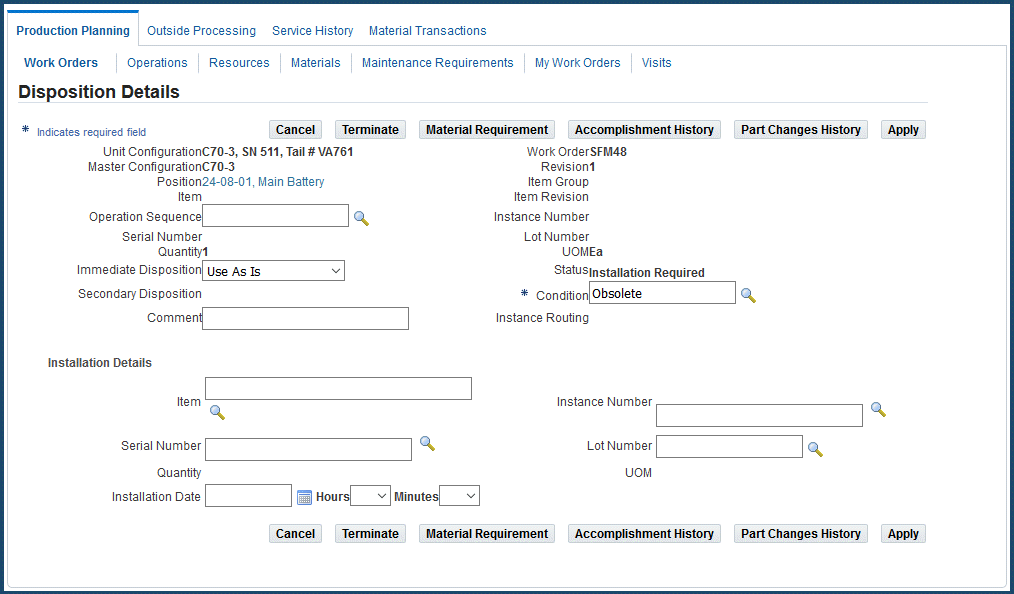
-
Click the Terminate button to close the disposition.
-
Click the Material Requirement button to create a material requirement for the disposition item and quantity.
-
Click the Apply button to save the changes.
-
-
Click the Create button on the Work Order Disposition page to create a new disposition.
Select an item to include in the disposition using the Position, Item Group or Instance search criteria. Enter the disposition details as required. Select the condition for the disposition.
-
Click Apply.
The page will refresh with the applicable disposition details listed in the lower half of the page. If the item being dispositioned is a tracked item, you must perform the parts change as required. If the item being dispositioned is non-tracked, you can associate the appropriate material transactions with it.
Additionally, you can create material requirements to support the disposition, submit quality results if submitting for the disposition MRB review, or create additional service requests if necessary.
Disposition Items from the Parts Change User Interface:
-
You can enter disposition details when performing an item or a unit configuration parts change.
Navigate to the Work Order Operations page and select Perform Part Removal/Install.
The Unit Configuration Part Changes page appears displaying the configuration tree.
-
Select the position against which you want to perform the disposition.
The page refreshes displaying the position details. The input parameters for disposition appear in the lower half of the page.
-
Enter the required information.
-
Click the Apply button to save your changes.
Disposition Association During Material Transactions
Use the Material Issue page to issue materials to a work order. You can associate the existing dispositions for the work order and issue parts directly to disposition. Click the Disposition search icon in the Work Order Requirements table to navigate to the Select Disposition page and select the appropriate disposition.
When returning materials issued to a work order, the dispositions associated with the work order appear in the Work Order Return Results region. This enables for the disposition to be directly associated with a material transaction.
You can associate a disposition to a material transaction for a non-tracked item after the transaction has occurred. Query for the material transaction in the View Material Transaction page. Select the transaction and click Associate Dispositions to navigate to the Update Associated Dispositions page to select the dispositions to associate. Select the dispositions to associate with the material transaction.
Updating Dispositions
-
Navigate to the Work Order Dispositions page.
-
Query for specific dispositions using the search criteria in the Filter Dispositions By region. Select the disposition that you want to update.
-
Click the Position link to view the position details. Click the Details icon to navigate to the Disposition details page.
-
Modify the information as required.
-
Click the Apply button to save your changes.
Viewing Item/Part Service History
Maintenance planners can access the history of service performed against a unit or part during the planning phase of a service or the execution of a work order. The history of the performed service, enables the planner to plan and execute decisions about the currently planned service, as well as provides support for the maintenance engineer during work order execution. The planner or maintenance engineer is able to view a detailed service history on a work order part such as maintenance requirements, jobs, visits and operations that have been performed on the part. The service history includes both inhouse service as well as supplier-performed service (OSP).
You must enter the item and serial number or instance number to view the service history of an item and serial number. You can search for work orders for the entered part or serial number or search for maintenance requirements associated to the part or serial number. You can restrict the search by providing additional filters such as the work order scheduled Start and End date range, work order Actual Start and End dates, mechanic, organization, department, machine, visit, program type, and so on.
To view work order history
-
Click the Execution link, and then click the Service History tab. The Search Work Orders page appears.
Enter your search criteria and click the Go button.
-
Click the Work Order Number link to navigate to the Work Order Operations page and view the work order details, the materials, resources, assignments, resource transactions, and dispositions associated to the work order.
-
You can perform the following:
-
Select a work order with an associated OSP order number and click View OSP Details to view the order details.
-
View the visit task details.
-
View maintenance requirements associated with the visit.
-
View service requests associated with the visit.
-
To view maintenance requirements history
-
Click the Maintenance Requirements tab. The Search by Maintenance Requirements page appears.
-
Enter your search criteria and click the Go button. The date range filter must be applied against the MR's effective from and effective to date. Maintenance requirements meeting your search criteria are listed in the maintenance requirements results region.
-
Click the Maintenance Requirement link to view the details of the selected maintenance requirement.
-
Click the Work Order Details icon to view work orders associated with the maintenance requirement.
The Maintenance Requirements Work Orders Listing page appears displaying the details of the associated work orders. Click the Work Order Number link to navigate to the Work Order Operations page and view all the materials, resources, assignments, resource transactions, and dispositions associated with the work order.
-
Click the Visit Task Details button to view the visit details, hierarchy, and cost information pertaining to the visit associated with the work order.
-
Click the Relationships icon to view relationships for a group MR. The Maintenance Requirement Relationships Listing page appears displaying all the child MRs.
My Work Orders Interface
The My Work Orders user interface displays all the work orders for the user logged in the system. Employees can record labor time and sign off work orders and operations assigned to them from one central location. Users can sign off and transact simple work orders especially those associated with standard line maintenance visits. Additionally, users can also perform other work order execution actions such as parts change, non-routine creation, quality recording, and so on.
Note: You can now create a non-routine work order from an existing non-routine work order by selecting the appropriate non-routine work order from the My Work Orders page. You can perform this action by adding the function, Allow creation of a Non-Routine originating from a Non-Routine. The corresponding function is AHL_ALLOW_CREATE_NR_FROM_NR to the menu associated to a responsibility.